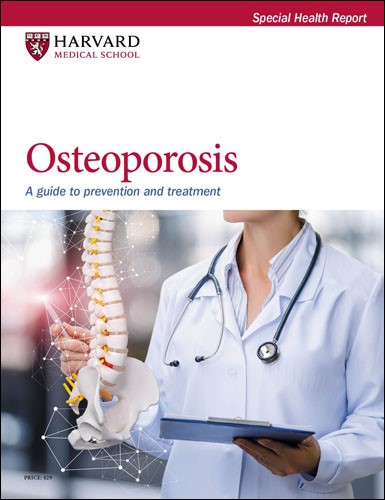No bones about it
Men get osteoporosis, too. Here's how to protect yourself from this common bone-weakening disease.
- Reviewed by Howard E. LeWine, MD, Chief Medical Editor, Harvard Health Publishing; Editorial Advisory Board Member, Harvard Health Publishing

Although osteoporosis, the bone-weakening disease, strikes more women, men are not immune. In fact, estimates suggest about 6% of men ages 65 and older have osteoporosis, and about one in five will break a bone because of it. Research also has shown that following a fracture due to osteoporosis, men are more likely to die than women.
"Looking out for your bones is equally important as other aspects of your health as you age," says Dr. Harold Rosen, an endocrinologist with Harvard-affiliated Beth Israel Deaconess Medical Center. "There are many ways men can keep their bones strong to help prevent osteoporosis or slow its progress if it occurs."
Close to the bone
During your life, bones undergo a continuous maintenance cycle called remodeling, in which they are simultaneously broken down and rebuilt. But as you age, the body eventually loses bone faster than it can rebuild it. This is what causes osteoporosis, where bones become thinner, more porous, weaker, and more susceptible to fractures. Most men begin losing bone density around age 60, and over time, they can get osteoporosis. Besides age, other factors can contribute to osteoporosis, including smoking, heavy alcohol use, family history, and chronic diseases of the kidney, lungs, stomach, and intestines.
Several medications, when used over the long term, can significantly increase the risk of osteoporosis. Chief among these are corticosteroids, like prednisone, used to treat inflammatory bowel disease and other inflammatory and autoimmune disorders.
Other medications that may cause the problem include androgen deprivation therapy, used to treat prostate cancer; anticonvulsants for epilepsy; certain drugs given to organ transplant patients; and some chemotherapy drugs.
Slowing the loss
Preventing osteoporosis and treating it if it occurs is about trying to stop or at least slow the bone loss. "It's sometimes possible to slightly increase bone density, but the main goal is to preserve as much of your bone mass you have left," says Dr. Rosen. Here are some ways to help do that.
Calcium and vitamin D. Both calcium and vitamin D work together to keep bones healthy. Calcium is a building block of bone, while vitamin D helps the body absorb calcium. For older adults, the goal of adequate calcium intake is to limit bone loss.
"Consuming more calcium does not mean you are feeding your bones calcium. Instead, you are supplying your body with enough calcium so it won't pull calcium from your bones and thus weaken them," says Dr. Rosen.
The recommended daily calcium intake for men ages 50 to 70 is 1,000 milligrams (mg); for men ages 71 and older, it's 1,200 mg. Recommendations for vitamin D are 15 micrograms (mcg) or 600 international units (IU) daily until age 70 and then 20 mcg (800 IU) afterward. How can you tell if you lack calcium or vitamin D? Dr. Rosen says to examine your diet and outdoor exposure. "It's often easy to get enough calcium through a regular healthy diet." he says.
For instance, one cup of milk, yogurt, or calcium-fortified orange juice, or an ounce of cheese all have between 300 and 400 mg of calcium each (and 100 IU of vitamin D in fortified milk). "So, eating three or four servings can give people plenty of calcium," says Dr. Rosen. Other good calcium sources include one cup of soymilk (300 mg), ½ cup of tofu (138 mg), and ½ cup of cooked turnip greens (100 mg).
Sunlight exposure is the best way to improve your vitamin D level. One study found that eight to 10 minutes of sun exposure to 25% of the body (hands, face, neck, and arms) produces the recommended daily amount of vitamin D in people with light skin. (People with darker skin may need 15 to 30 minutes of sun exposure.)
But that can be a challenge in the winter or if you live in a northern climate, or if you're diligent about limiting sun exposure for skin care reasons. (Sunscreen blocks UVB light, but few people put on enough to block all UVB, or they use sunscreen irregularly, so sunscreen typically has a limited effect on vitamin D level.)
Therefore, Dr. Rosen recommends taking a daily multivitamin or a vitamin D supplement. For most people, a 1,000 IU dose is sufficient. (Most multivitamins also contain a decent amount of calcium — around 200 to 300 mg.)
Exercise. Research has suggested that weight-bearing activities (in which your bones support your weight) can help to slow bone loss and even increase bone density, although estimates suggest it's a modest 1% to 2% increase in adults.
Weight-bearing examples include speed walking, running, stair climbing, and elliptical training. These activities put stress on bones that, in turn, pushes bone-forming cells into action. Regular exercise also builds muscle and improves balance and agility, all of which helps lower your risk of falls.
Dr. Rosen suggests adopting an exercise program that includes weight-bearing activities, strength training, and balance, stretching, and flexibility exercises, such as yoga, tai chi, or Pilates.
Medications. Low testosterone levels can contribute to osteoporosis. Men with confirmed low levels of this hormone should consider a bone density test (see "Do you need a bone density test?"). "Replacing testosterone can help maintain and might even improve bone health," says Dr. Rosen.
A class of drugs known as bisphosphonates can treat osteoporosis in men by reducing the rate at which bones break down. Examples include alendronate (Fosamax), pamidronate (Aredia), risedronate (Actonel), and zoledronic acid (Reclast). Talk with your doctor about whether testosterone therapy or bisphosphonates are warranted.
Do you need a bone density test?Osteoporosis is called a "silent disease" because there are typically no symptoms, and most people who have it don't know until they break a bone. One way to diagnose osteoporosis and determine future fracture risk is with a bone density test, which uses specialized x-rays to measure the thickness and strength of bones. The lower your bone density, the higher your risk of breaking a bone. Speak with your doctor about whether you may benefit from this test. |
Image: © Christopher Pattberg/Getty Images
About the Author

Matthew Solan, Executive Editor, Harvard Men's Health Watch
About the Reviewer

Howard E. LeWine, MD, Chief Medical Editor, Harvard Health Publishing; Editorial Advisory Board Member, Harvard Health Publishing
Disclaimer:
As a service to our readers, Harvard Health Publishing provides access to our library of archived content. Please note the date of last review or update on all articles.
No content on this site, regardless of date, should ever be used as a substitute for direct medical advice from your doctor or other qualified clinician.
















